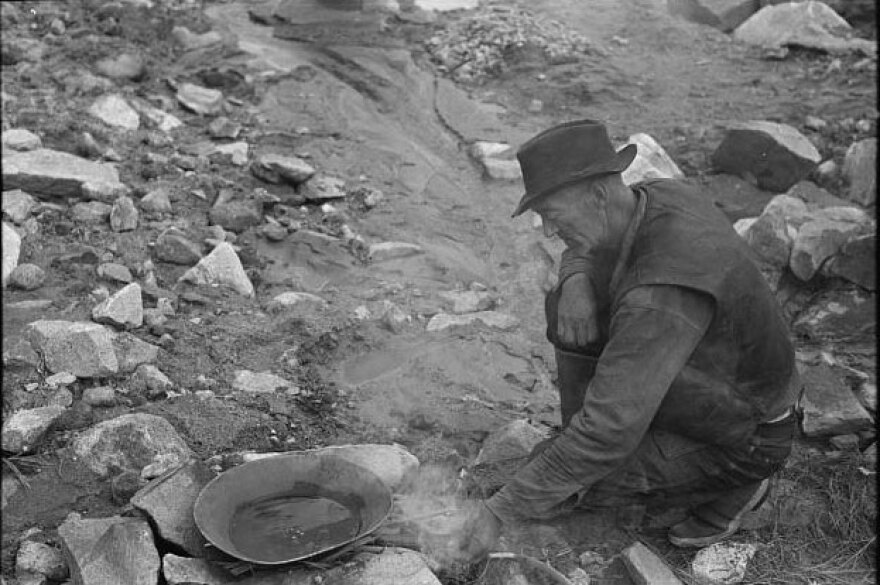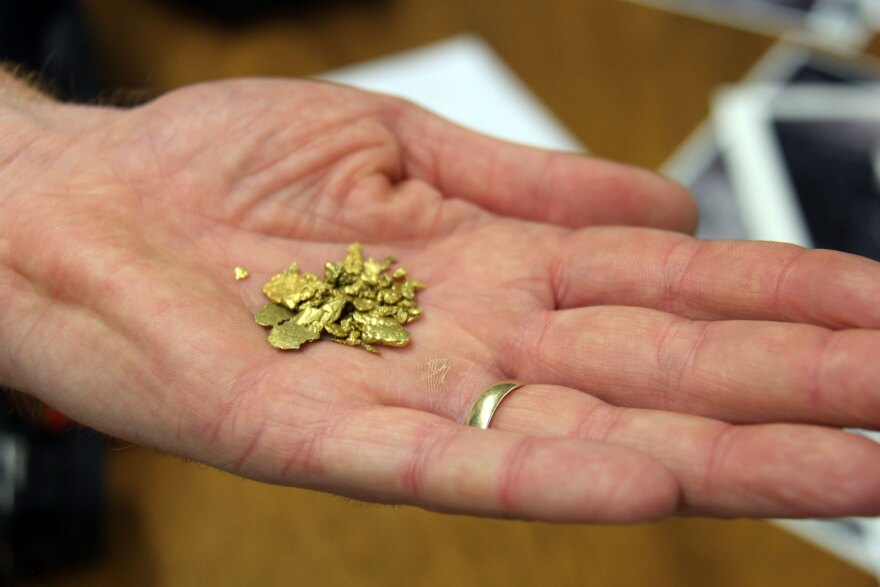You've probably heard about the California gold rush of 1849 — but did you know that Vermont had its own mini-gold rush beginning around that same time?
This month on Brave Little State, VPR’s people-powered journalism podcast, we do some digging into Vermont's glittery gold history.
Peter Brown of Vernon told Brave Little State that someone once told him that Vermont had two gold mines. And what he wanted to know was: Is this true? And if so, where were the mines, and when were they used?
It's just one of the questions that Brave Little State took on in its recent episode: Your Vermont History Fix, From Gold Mines To Witch Windows.
The short answer to Peter's question is: yes. For a time, Vermont had many more than two gold mines.

Beginning in the 1850s, the discovery of gold flakes in Vermont rivers spurred a flurry of speculative investment, mine blasting and sluicing — and even a new town that grew up around the short-lived mines.
The story goes that two Vermonters returned home to south central Vermont after digging for gold in the Sierra Nevada.
"[They] realized that the topography of our part of Vermont was quite similar to Sutter's Mills in California," says Coleman Hoyt, an amateur historian. (Sutter’s Mills was a hotspot for gold in the Sierra Nevada.)
Hoyt says the men would go fishing near Killington, "and by gosh they found little sparkling nuggets in our brooks, in Bridgewater and Plymouth, and that started the gold rush here."

Vermont's state geologist Marjorie Gale has a copy of an 1861 map that shows thick gold lines marking all the places surveyors eventually found gold.
The marks show what seems like a river of gold following the spine of the Green Mountains, with a few areas of higher concentration in the Plymouth Bridgewater area, east of Killington Peak.
It seems like a treasure hunter’s dream, but Gale says it wasn't an "economically or commercially viable operation."
But, she adds, "certainly people go out, and find flakes of gold."
And to this day, you can still walk through the forest and poke around the remnants of the old mines.
Subscribe to Brave Little State:
Loading...
Panning for gold
On a recent summer day, Nelson Illinski took me on a visit to Camp Plymouth State Park, to walk up an old four-wheel drive trail to the long-defunct Henry Fox mine.
Illinski is a gold panning hobbyist and a self-taught Vermont gold historian.
By studying old photos and maps, he's found the foundation of some mine buildings and underground tunnels. About a mile up the trail, the brook widens. Illinski holds up a photo from the 1800s that shows how there used to be several brick buildings alongside this brook.
There was a mill for crushing quartz chunks, housing for the workers and the office of the assayer, who was like a prospector. Part of the of the office foundation is still visible — about 4 feet of rock wall of what must have been a fairly large building.

Nearby, a twisted iron railroad tie is all that remains of the tracks that went into the now-collapsed horizontal mine shaft. The rails supported horse-drawn carts, which ferried piles of ore out of the underground mine.
"It actually travels for 300 yards up the mountain, to where the vertical shafts are," Illinski says.
Indeed, several hundred yards up a steep hill, there’s a gaping 20-foot-wide hole; it looks wildly out of place in the otherwise unassuming forest floor. Illinksi says this was the original dynamite-blasted hole, but it kept filling with water. So the miners dug the horizontal tunnel, which connected to the vertical shaft and drained it.

A flash in the pan
Collapsed mine shafts and crumbling building foundations are all that's left of the gold mining industry now.
But for a time, in the second half of the 19th century, south-central Vermont was home to a boom of mining activity.
Coleman Hoyt says a small but vibrant community grew up around the men who came to work gold mines. Called Plymouth Five Corners, the town had a hotel, a school and a dance hall.
"In Bridgewater, there were over 100 people working in gold mines. That's more people that worked on farms," says Hoyt. "It was the major occupation in Bridgewater, and in Plymouth."
He says Bridgewater's industry developed first in 1850s, right before the Civil War, and then again after the war ended. Hoyt says Plymouth saw more activity in the 1870s and 1880s.
Locals say that today that the community of Plymouth Five Corners is a virtual ghost town; the only remnants are the numerous cellar holes where homes used to stand.

By some accounts, Vermont had 40 to 50 mines in its heyday — but to be clear, a mine could refer to anything from dynamite-blasted piles of quartz to an actual mine shaft dug into the earth.
And no matter how you count the number of mines, the question of whether prospectors made any money from Vermont gold is not under debate.
State geologist Marjorie Gale says all her predecessors have been skeptical of the practice. She reads from one of their reports from 1930:
"Again, let me say that in my opinion it is entirely useless to throw away money, time and labor seeking gold in Vermont."
Gale says that echoes the sentiment of state geologists from earlier years, too:
"They just say, 'Stop, you shouldn't be investing in it, you might find some, but you're never going to get rich.'"

Both geologists — and eventually prospectors — determined that while there is gold in Vermont, there aren’t deposits large enough to make enough money to pay for all the digging and crushing and sluicing.
Still, Coleman Hoyt points out that a few people did make money off Vermont gold. He holds up a photocopy of a tiny booklet from the 1880s.
"These are the stock prospectuses of the Rooks Mining company — it sold a lot of stock," says Hoyt. "In fact, the publisher of these little booklets took off and disappeared with the money."
State reports don't paint a clear picture on what happened with the Rooks Mine, but a few terse references more or less support Hoyt’s account that it was likely a get-rich-quick scheme.
Vermont's gold legacy carries on
Still, while the industry may have been but a flash in the pan, that hasn’t stopped the tradition of panning for gold. It’s still happening in the very same brooks and streams that caught people’s imagination in the 1850s.
Skilled hobbyists like Nelson Illinski are still working the rivers, and teaching others how to pan for gold.
Back in Camp Plymouth State Park, about a mile downstream from the old Rooks Mine, Illinski breaks out his shovel and gold pan. He picks a river bend where the water would likely have deposited some of the heavy metal, and starts digging.

Once he's filled a green plastic gold pan with silt, he holds it just under water and starts shaking. The sandy bits float out of the pan, but some heavier sand — and hopefully gold — stay in the bottom.
Indeed, after a few digs, he's struck gold. He points to a tiny fleck glittering in the bottom of the pan; it's barely visible, much smaller than a pencil point.
"See how it sticks to the bottom of the pan?" he asks, and gently sloshes the water in the pan: “Now watch everything else around it ... [it] moves, and the gold glues to bottom pan. That's how you know it's gold."
But Illinski is not going to get rich off today's haul.
"Believe it or not, 10 of those [specks] make a dollar. So, it takes a lot of gold," he says with a laugh.
Illinski and his wife spend many summer weekends panning for gold, and he teaches a gold panning class for any would-be enthusiasts. He's mastered the art of reading a river and finding those milky quartz veins that may contain gold.
Illinksi says Yankees are tight-lipped about how much gold they've collected, but he gathers about an ounce a year of Vermont gold — and it's as close to pure as you'll find: 23.5 carats.

But Illinski says he wouldn't sell it.
For him it's just about the hunt, and spending time outdoors with family, and teaching others about Vermont's gold history.
Loading...






